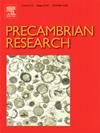大陆尺度碳酸盐沉积与舒兰-旺冈远足的环境关联
IF 3.2
2区 地球科学
Q2 GEOSCIENCES, MULTIDISCIPLINARY
引用次数: 0
摘要
埃迪卡拉纪地层记录了许多区分新元古代-显生宙过渡的地球生命特征。然而,很难确定埃迪卡拉纪事件之间的因果关系。本文重点研究了北美埃迪卡拉系碳酸盐岩面积、体积、地球化学和沉积环境的定量特征。碳酸盐沉积和地球化学模式与海侵/退回旋回大致一致,这些旋回旋回与冈瓦纳合并、面向大陆的俯冲和晚期罗迪尼亚裂陷等冰川-海面和全球/区域构造作用有关。高负碳酸盐碳同位素值表明Shuram-Wonoka碳同位素偏移(SW-CIE)与碳酸盐数量(>;55 - 60%白云岩)的显著增加相吻合,其沉积环境跨越近岸、外陆架和斜坡/盆地沉积环境。大陆上碳酸盐沉积程度的增加可能表明海侵,在地层学上似乎受到与Gaskiers和loquan /Hankalchough冰川有关的冰川影响地层的限制。碳酸盐沉积的增加也与埃迪卡拉纪生物群的首次出现大致一致。在埃迪卡拉纪晚期,主要沉积在近岸环境的碳酸盐岩数量的后续脉冲与生物矿化物的出现相吻合,这可能表明浅海陆架范围、碳酸盐岩沉积和宏观演化的共同原因驱动因素。全面的埃迪卡拉纪宏观地层框架为主要的生物和地球化学事件提供了时间、空间和环境方面的明确背景,并为未来动物生命开始时的假设检验提供了一个平台。本文章由计算机程序翻译,如有差异,请以英文原文为准。

Continental-scale carbonate sedimentation and environmental correlates of the Shuram-Wonoka excursion
Strata of the Ediacaran Period record many Earth-Life features that distinguish the Neoproterozoic-Phanerozoic transition. However, it is difficult to determine cause and effect relationships between Ediacaran events. Here we focus on quantitative properties of carbonate rock area, volume, geochemistry, and depositional environments from the North American Ediacaran System. Patterns of carbonate sedimentation and geochemistry are broadly coincident with transgressive/regressive cycles which have been linked to glacioeustacy and global/regional tectonic forcings of Gondwana amalgamation, continent-facing subduction, and late-stage Rodinia rifting. Highly negative carbonate carbon isotope values distinguishing the Shuram-Wonoka carbon isotope excursion (SW-CIE) coincide with a marked increase in carbonate quantity (>55–60 % dolostone), which spans nearshore, outer shelf, and slope/basin depositional environments. This increase in the extent of carbonate sedimentation on the continent likely indicates marine transgression and appears to be stratigraphically bounded by glacially influenced strata associated with the Gaskiers and the Luoquan/Hankalchough glaciations. This same increase in carbonate sedimentation is also broadly coincident with the first occurrences of the Ediacaran biota. A subsequent pulse in carbonate rock quantity in the latest Ediacaran, dominantly deposited in nearshore environments, coincides with the appearance of biomineralizers, potentially indicating common cause drivers for the extent of shallow marine shelves, carbonate sedimentation, and macroevolution. A comprehensive macrostratigraphic framework for the Ediacaran provides a temporally, spatially, and environmentally explicit context for major biological and geochemical episodes and serves as a platform for future hypothesis testing at the dawn of animal life.
求助全文
通过发布文献求助,成功后即可免费获取论文全文。
去求助
来源期刊

Precambrian Research
地学-地球科学综合
CiteScore
7.20
自引率
28.90%
发文量
325
审稿时长
12 months
期刊介绍:
Precambrian Research publishes studies on all aspects of the early stages of the composition, structure and evolution of the Earth and its planetary neighbours. With a focus on process-oriented and comparative studies, it covers, but is not restricted to, subjects such as:
(1) Chemical, biological, biochemical and cosmochemical evolution; the origin of life; the evolution of the oceans and atmosphere; the early fossil record; palaeobiology;
(2) Geochronology and isotope and elemental geochemistry;
(3) Precambrian mineral deposits;
(4) Geophysical aspects of the early Earth and Precambrian terrains;
(5) Nature, formation and evolution of the Precambrian lithosphere and mantle including magmatic, depositional, metamorphic and tectonic processes.
In addition, the editors particularly welcome integrated process-oriented studies that involve a combination of the above fields and comparative studies that demonstrate the effect of Precambrian evolution on Phanerozoic earth system processes.
Regional and localised studies of Precambrian phenomena are considered appropriate only when the detail and quality allow illustration of a wider process, or when significant gaps in basic knowledge of a particular area can be filled.
 求助内容:
求助内容: 应助结果提醒方式:
应助结果提醒方式:


